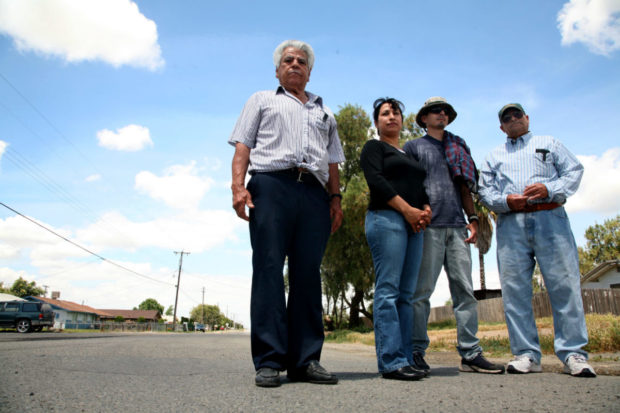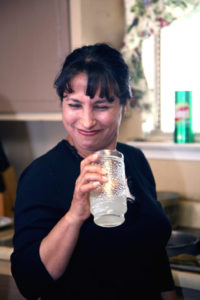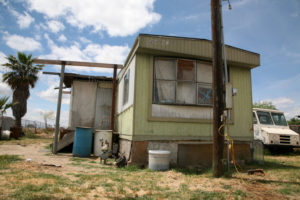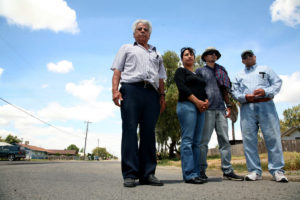
By David Bacon

When Mary Broad moved to Lanare in 1955, there were only four other families still living in this tiny, unincorporated community in the middle of the San Joaquin Valley, halfway between old Highway 99 and Interstate 5 on the cracked blacktop of Mt. McKinley Avenue.
It wasn’t always this way. Lanare used to be a company town, taking its name from rancher and speculator L.A. Nares, one of the last of a string of speculators from the east who became owners of the old Spanish land grants—in his case, the Rancho Laguna de Tache. From 1912 to 1925, the town had a post office and a station on the Laton and Western Railway.
Lanare and its neighbors drew their water and life from the Kings River. The next town up the road even changed its name from Liberty Settlement to Riverdale to advertise its proximity. But through the first half of the 1900s, farmers tapped the Kings in the Sierras to the east to irrigate the San Joaquin Valley’s vineyards, orchards and cotton fields. Instead of flowing into the valley past Lanare and Riverdale, in most years the stretch below the mountains became a dry riverbed. Eventually, Tulare Lake, the river’s terminus, itself was drained for farmland and disappeared.
So, almost, did Lanare. Its people left, and only a few families remained. But in California’s housing crunch of the last few decades, Lanare began to grow again. For farm laborers, truck drivers and poor rural working families, living in Lanare was cheaper than urban Fresno 50 miles away.
But for these new residents, the dry riverbed and a century of using its water for irrigation have spelled bad news. Today, Lanare’s water comes from a well. And in this low-lying area of the San Joaquin Valley, chemicals have become concentrated in the water table. It was no surprise, therefore, that residents discovered their water had high levels of arsenic, a poison. Since then, their effort to find water they can drink has been a search for the life of their town itself.
By 2000, Lanare had 540 residents. A decade later, 589. People mostly moved into trailers. Because most are farmworkers in the surrounding fields, a third live under the poverty line, with half the men making less than $22,000 per year and half the women less than $16,000.
Today, Lanare is one of the many unincorporated communities in rural California that lack the most basic services, like drinking water, sewers, and even sidewalks and streetlights. According to Policy Link, a foundation promoting economic and social equity, “Throughout the United States, millions of people live outside of central cities on pockets of unincorporated land. Predominantly African-American and Latino, and frequently low-income, these communities…have been excluded from city borders.”
Three years ago, Policy Link partnered with California Rural Legal Assistance (CRLA) to create the Community Equity Initiative to find answers to the critical situation of Lanare residents and others like them. The San Joaquin Valley alone is home to more than 220 unincorporated communities, with an estimated population of almost half a million.
In 2002, Lanare residents got a $1.3 million grant from the federal government to build a plant to remove the arsenic. But after it went online five years later, it ran for only six months. After that, the community’s residents no longer had enough money for the chemicals and power to keep it going. Even shut down, however, they still have to come up with $54 every month to cover that loan, basically paying for water they can’t drink. Inside every home there’s a faucet with water you might risk using to wash dishes or clothes. But when Angel Hernandez or Isabel Solorio hold up a glass to the light, the water is cloudy. So in the corner are the stacks of water bottles for drinking and cooking.
In the summer heat, on the border between Fresno and Merced counties, the temperature rises above 100 degrees. Water is no luxury. It sustains life. Everyone has to drink enough to replace what their bodies lose, even those like Mary Broad, who sits in the shade of her porch most days.

Dozens of similar small communities, or colonias, spread out across the state have similar water problems. Activists in 17 unincorporated areas of next-door Tulare County formed AGUA, La Asociacion de la Gente Unida por el Agua (The Association of People United for Water).
In Lanare, Hernandez, Solorio and several other residents, including Juventino Gonzalez and Jesus Medina, organized a group to press the state to take responsibility for providing water, Comunidad Unida en Lanare (Community United in Lanare). As a first step, they asked the state to survey Lanare and surrounding communities, acknowledge that such a need exists and make a plan to meet it. The CRLA filed suit on their behalf last year, saying California’s Safe Drinking Water Act requires the state to formulate a Safe Drinking Water Plan.
The state hasn’t come up with a Safe Drinking Water Plan since 1993. CRLA attorneys point out that if authorities had followed the law and come up with one, it would have been obvious that this small, poor community could not have afforded to operate an expensive arsenic treatment plant. Letting the state off the hook, however, a local Fresno County judge ruled that California’s budget crisis trumped its obligation to create such a plan.
The state budget crisis, however, hasn’t stopped nearby Riverdale, only four miles from Lanare, from proposing another arsenic removal plant. The Riverdale Public Utilities District hopes to use funds from Proposition 84, a $5.4 billion water bond. It was just awarded $500,000 for a preliminary study for a project that would break ground next year.
CRLA lawyer Phoebe Seaton wrote to the state health department saying that, “Given finite and scarce state and federal resources, the need for a safe, reliable and affordable source of water for both Lanare and Riverdale, and the Department’s statutory duty to explore consolidation of water systems, the Department must consider the consolidation of Lanare’s and Riverdale’s water systems.”

Public health officials, however, say connecting Lanare to that Riverdale plant, or even expanding Lanare’s own idle plant, would be too expensive. The state has hired a private contractor to operate the Lanare plant, but the operation is in receivership, and it hasn’t produced water anyone can drink for four years. When the Public Health Department wouldn’t say whether Lanare was included in its plan, Comunidad Unida began working with Fresno County’s Local Agency Formation Commission (LAFCo), which is charged with avoiding expensive duplication of municipal and county services, including water.
In a report due to be released on August 24, LAFCo Executive Officer Jeff Witts notes that “residents are currently relying on failing septic tanks for wastewater services, there are no streetlights, sidewalks, and there is no adequate storm water drainage. The levels of poverty in Lanare make it that much more important that residents have access to an affordable source of drinking water.”
The LAFCo report concludes that “a shared arsenic treatment facility that serves both Riverdale and Lanare would provide operational efficiencies and economies of scale that would improve service, water quality and affordable access to clean water for both communities.” It even advocates a system to allow Lanare residents to abandon their failing septic tanks and connect to the sewers of Riverdale.
Meanwhile, however, the water in Lanare still looks cloudy and residents fear drinking it. And they still pay $54 a month for it. “The government has forgotten us—they live outside our reality,” says Gonzalez, who moved to Lanare 41 years ago, when it only had 12 families. “All that time we’ve been isolated from the larger communities around us, while our neighborhood gets filled with drugs and trash. Water’s just one problem, but if we can find an answer to it, maybe we can solve others too. We’re willing to try almost anything.”
*****
David Bacon is an award-winning photojournalist, author, labor organizer and activist for immigrant rights. Mike Davis calls him “the conscience of American journalism.” For more articles and images, visit http://dbacon.igc.org.

11 YEARS LATER AND STILL NOTHING IS BEING DONE TO HELP MY PEOPLE OUT ………NOW THE WATERA NOT EVEN CLOUDY ANY MORE ITS BROWN AND FEELS SLIMY WHEN YOU SHOWER YOU FEEL MORE DIRTIER THEN WHEN YOU FIRST GOT IN